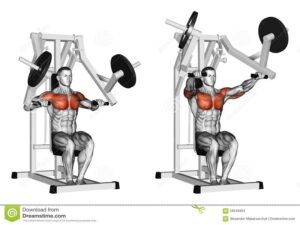Though the upper body as a stabilizer, the hammer press is primarily a chest workout. The vertebra, anterior scapula, triceps, and biceps are during a hammer press. However, since a Hammer strength chest press is on a weight machine from Lifetime Training with the same name, it requires workout equipment.
How to do Hammer Strength Chest Press?
You will require a flat bench similar to the one you use for bench presses. It has an inclination bench that can lay flat for this workout. It is a chest builder exercise that builds your strength. To perform the steps, you require an additional small set of dumbbells. Start with a portion (between fifteen and thirty percent) of your number.
Steps to Follow:
- Once you’ve learned the version, you can raise the pressure. When you have those two things, you perform a hammer press by starting in the position described in the following manner:
- Now, at the end of the wooden bench with feet flat on the ground and two dumbbells close at hand.
- Be sure your feet are such that they are under your thighs.
- Pick up one weight while leaning forward. Grab the second one while keeping the first one on your leg.
- Recline and lie down on the bench after both dumbbells are on each person’s thighs.
- Be careful not to allow your wrists to open out or extend out to the sides when you return the weight to your chest such that your chest expands and pull your neck and shoulders back.
Benefits of Hammer Strength Chest Press:
It’s a terrific approach for bodybuilders and professional lifters to deplete their chest muscles. In this way, their bodies may increase the muscle strength through hypertrophy, even though the difference might not be life-altering. Hammer bends are among those who already have shoulder problems because the emphasis is on the chest muscles. The shoulders have much simpler if you don’t lower the weights to your chest.
Muscles worked in hammer press:
Complex Bicep muscle
The anterior deltoid on the front of the shoulder, rotates the forearm inward and propels the arms forwards. The arm muscles, especially the deltoids, are primarily used during top presses, which the hammer press most definitely is not. Yet, a hammering press, the anterior deltoid exerts significant supporting force.
Trapezius muscle
The vertebra, which connects to the femur, or forearm bone, near the external abdominals, ribs, and clavicle, is what lifters refer to when we want to develop pectorals. The chest muscle is this one. The pectoralis major lifts the arm out in front of the body, rotates it towards the midline of the body, and raises it out to the sides.
Triceps
It is an elbow extensor muscle that primarily helps to straighten the arm. The action of handing something to someone in front of you is by the triceps. The triceps serve as anchors during the hammer press, especially during the pushing phase of the activity, just like the anterior deltoid. All three triceps’ heads are in use because the triceps is contracting against force.
How Would You Effectively Do A Hammer Strength Chest Press?
The techniques to do are the following
Seat position:
For those who are fortunate enough to have accessibility to the sitting version of this machine, this is primarily for them. Hence, you cannot modify the flat bench. Now that out of the way, you can abide by the broad principles. The height may vary slightly from person to person due to the differences in our physique. Start by attempting to sit with the handles at shoulder height.
Hand position:
Any pressing movement involves a lot of hand position. Your strengths and the muscle depends on it. Hence, in this instance, it is recommended to visualize your hands as being in a straight line with another. It will as the “rack” you are pushing during strength training. Keep your hands at or below chest level and experiment with levels. It is to find the position that feels most comfortable.
Exercise execution:
Place your elbows at a 45-degree angle from your body to avoid excessive elbow flex. It is your elbow lineup changes, so does the position in which you apply pressure. Instead of pushing against the machine’s preset range of motion, you want to use.
Alternative Workouts to Chest Press:
Weighted Chest Press
The dumbbell press is a good substitute for the hammer strength chest press while working your chest. It essentially mimics a cross between the bench press and the dumbbell floor press, but since you’re not using a bar. It helps prevent instabilities, and if you mess up, you can drop the weights instead of getting crushed by the barbell. With all the inexpensive dumbbells on the market, you don’t need to spend money on equipment. All you need to know is where to go for a solid dumbbell set.
Thoracic with dumbbells
An all-time favorite among bodybuilders. Because it hits the entire chest at once, it’s fantastic. It stands out because it concentrates on strengthening the muscle fibers. It is closest to the sternum, enabling excellent chest spacing.
Siege Press
It is a starting point to load up a little to build muscle but isn’t quite ready for the chest or high press. Anyone arm mobility concerns that prohibit them from performing standard presses should also consider this option. By angling the bar, this exercise reduces a deal of the strain that traditional pressing entails while still targeting the chest, shoulders, and triceps.
Final words:
Using a chest press or hammer-strength chest press machine has various advantages. Interestingly, you can typically perform more repetitions on these because your chest is the sole major muscle that is activated. Compared to the dumbbell variety, the arms beginning apart and winding up closer together. It cover more of the pectoralis major’s range of motion. However, this relies on you’re utilizing the machine and how you perform the hammer press with dumbbells. Hammer presses are frequently in a chest fitness regime among the othe

